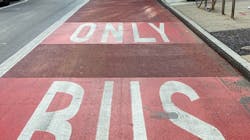SEPTA releases results of 70-day Hayden AI camera-assisted bus lane enforcement pilot project
According to the Southeastern Pennsylvania Transportation Authority (SEPTA), an average of 4,000 weekly violations occurred along two bus routes that were studied as part of an AI camera-assisted pilot program conducted over the spring and early summer. The findings are intended to raise awareness about the safety issues these violations create and inform discussions about enforcement solutions.
The 70-day pilot program, which SEPTA conducted with Hayden AI, provided valuable data illustrating key hot spots where vehicles were illegally parked in transit zones. The camera system was mounted inside seven buses on Routes 21 and 42 from April 20 to June 28, 2023, and automatically detected illegally parked vehicles on the Chestnut Street and Walnut Street bus lanes and at bus stops. The system utilized computer vision technology to recognize and capture images of vehicles obstructing bus lanes and bus stops.
“This study provides us with data that clearly illustrates the high frequency of these violations and how we can use cutting-edge technology to combat these problems,” said SEPTA CEO and General Manager Leslie S. Richards. “Reducing these violations will improve safety for our customers, pedestrians and motorists, along with making our bus service more efficient and reliable.”
Among the study’s key findings were:
- 36,000 bus lane and bus stop parking obstructions
- 32,000 bus stop parking violations
- 50 percent of bus stops obstructed at some point
- One in five of all vehicles noted had out-of-state license plates
- More than 10,000 riders negatively impacted by delays and other service disruptions
The study documented 36,392 total parking obstructions in the pilot zone, which included bus lane obstructions in Center City and bus stop obstructions in West Philadelphia and a portion of Upper Darby. In Center City, the study detected 4,174 obstructions in bus lanes.
SEPTA says the routes were selected because they utilize the Chestnut Street and Walnut Street bus lanes in Center City. On the West Philadelphia and Upper Darby portions of these routes, where there are no bus lanes, the bus stop obstruction detection technology was enabled.
In 2022, the average speeds of the 21 and 42 routes were 8.5 mph and 8.7 mph, respectively, making these routes the fourth and fifth slowest of SEPTA’s high ridership routes. Slow speeds and poor reliability impact the more than 10,000 riders these routes carry on an average weekday.
The report also detailed that when bus stop zones are illegally blocked, buses can be prevented from pulling up parallel to the curb, which forces riders into the street and makes it difficult – or sometimes impossible – for wheelchair ramps to be deployed properly.
“For people with disabilities, just one car blocking a bus stop creates a serious hazard,” said Latoya Maddox, senior independent living specialist of Liberty Resources and chairperson of the SEPTA Advisory Committee for Accessible Transportation (SAC). “This is a problem that has been tolerated for far too long and we hope that action will be taken to change driver behavior and make the streets of Philadelphia safer for our community.”
Both New York City’s Metropolitan Transportation Authority and the San Francisco Municipal Transportation Agency have used this technology. In New York, where this type of technology has been deployed since 2019, saw bus speeds increase by as much as 40 percent on enforced routes. Bus collisions have also decreased significantly – by as much as 34 percent on certain routes.
